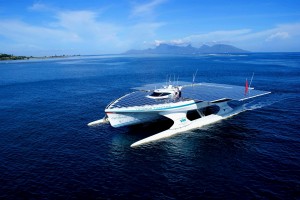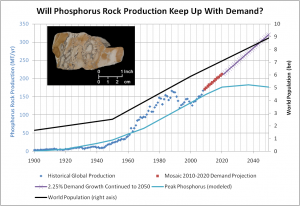I’d often considered biofuel to be an interesting development, one that could hopefully replace fossil fuels, with no real downside (though not exactly carbon neutral). However, I came across an interesting article talking about how biofuels, at least as currently envisioned, require phosphorus for growth. Meaning, we now face a ‘peak biofuel’ situation, or rather, ‘peak phosphorus’, where biofuel production capacity can be tied to limits on phosphorus production! Thus, while still worth pursuing, we need to be a bit more realistic in our expectations of how widely adopted biofuels can ever become. You can read the whole article here.
Catalytic-driven hydrogen generation
I’m seeing more and more reports of studies involving the use of catalysts to generate hydrogen. This is a fascinating development, so I’ll be posting more of those here (follow this link for a description of the work CalTech is doing on this). The basic premise is to heat water to a point where an added catalysts splits the water molecules into their oxygen and hydrogen components, the hydrogen is then used as fuel. More importantly, the hydrogen can then be stored for later use. For example, imagine a solar thermal collector used to generate the heat to drive this reaction, with excess hydrogen being stored for use during night. It’s a sort of hydrogen battery, if you will.
This research is still in the laboratory stage, but is an interesting path to sustainable energy solutions which address the energy storage concerns.
NREL energy analysis
The National Renewable Energy Laboratory (NREL) has published a study that looks at the extent to which renewable energy can meet the demands of this country over the next few decades. What they found was that existing technologies, that are commercially available today, are more than sufficient to provide 80% of total electricity generation by 2050.
No one wants to pay higher prices for electricity to fund this, but the reality is that the course we’re on is unsustainable and change is inevitable. The sooner we begin that change, the smoother it will go. So what are we waiting for?
Deaths by energy source
Forbes has an interesting article looking at the health effects of different energy sources, more specifically, the number of (human) deaths per unit of energy produced. For all the publicity nuclear energy accidents get, it’s worth noting that the mortality rate from nuclear energy is about 90 deaths per tkWhr (trillion kilowatt hour of energy produced), while coal is 170,000 deaths per tkWhr! To be fair, that coal rate is the global average and the US is much better than that (mainly because of existing pollution controls)…but even then, it’s a whopping 15,000 deaths per tkWhr. The complete list:
Energy Source Mortality Rate (deaths/trillionkWhr)
Coal – global average 170,000 (50% global electricity)
Coal – China 280,000 (75% China’s electricity)
Coal – U.S. 15,000 (44% U.S. electricity)
Oil 36,000 (36% of energy, 8% of electricity)
Natural Gas 4,000 (20% global electricity)
Biofuel/Biomass 24,000 (21% global energy)
Solar (rooftop) 440 (< 1% global electricity)
Wind 150 (~ 1% global electricity)
Hydro – global average 1,400 (15% global electricity)
Nuclear – global average 90 (17% global electricity w/Chern&Fukush)
You can read more over at Forbes.com.
Solar powered boat completes round the world journey
 I have mixed feelings about this one. PlanetSolar is less than one day from completing a circumnavigation using a boat powered only by the sun; it’s taken them about 600 days to do this. I’m not quite sure what they’re trying to prove here. If you want to go ‘green’ on your trip around the world, solar just can’t compete with wind. Sailboats are a proven ‘green’ technology that are faster and can go more places in the world’s oceans (PlanetSolar is limited more to the equatorial regions where the sun’s more direct rays result in more powered gathered by the solar panels). Likewise, storms pose little challenge for sailboats but the cloud cover hurts the performance of PlanetSolar. Yes, solar is useful even on sailboats for powering shipboard electronics, but when it comes to propulsion, the abundant wind on the oceans is a fantastic, proven resource.
I have mixed feelings about this one. PlanetSolar is less than one day from completing a circumnavigation using a boat powered only by the sun; it’s taken them about 600 days to do this. I’m not quite sure what they’re trying to prove here. If you want to go ‘green’ on your trip around the world, solar just can’t compete with wind. Sailboats are a proven ‘green’ technology that are faster and can go more places in the world’s oceans (PlanetSolar is limited more to the equatorial regions where the sun’s more direct rays result in more powered gathered by the solar panels). Likewise, storms pose little challenge for sailboats but the cloud cover hurts the performance of PlanetSolar. Yes, solar is useful even on sailboats for powering shipboard electronics, but when it comes to propulsion, the abundant wind on the oceans is a fantastic, proven resource.
A solar boat? I don’t get it. Hoist the mainsail, matey.


